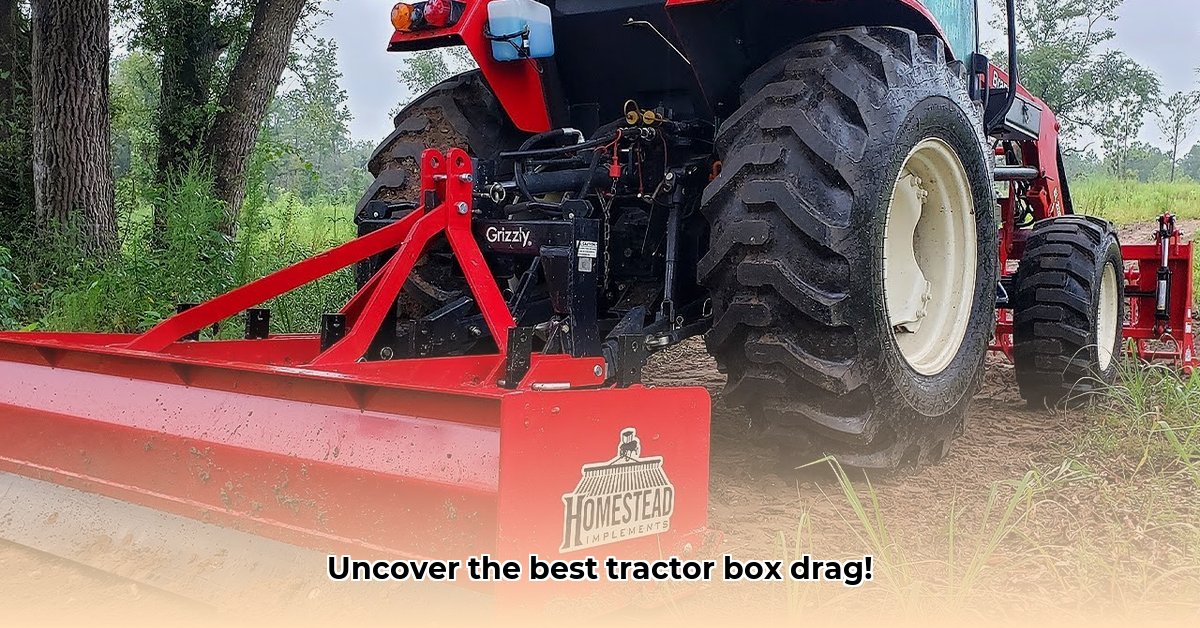
Choosing the right box drag (box blade) significantly impacts your farm's efficiency. This comprehensive guide compares top US-made models, helping you select the perfect one for your needs and budget. We'll examine key features, analyze various models, and offer actionable advice for maximizing your investment.
Key Features and Considerations for Box Drags
Several key features differentiate box drags, impacting performance and longevity.
Working Width
This dictates the area covered per pass. Wider blades are faster for large fields but less maneuverable in confined spaces. Consider the typical size of your working areas.
Tilt Angle
Adjustable tilt angles are crucial for working slopes and uneven terrain. This allows precise grading and leveling. Fixed-angle models offer simplicity but less versatility.
Ripper Shanks (Scarifiers)
These break up compacted soil. More shanks generally imply more aggressive soil penetration, improving drainage and seedbed preparation. Adjustable shanks offer greater control over soil disturbance.
Material Composition
High-strength steel, such as Hardox, offers superior durability and resistance to wear. While more expensive initially, it often translates to lower long-term costs due to extended lifespan.
Construction Methods
Precision laser cutting and robust welding techniques (e.g., robotic welding) contribute to a stronger, more reliable box drag. These construction methods minimize structural weaknesses over time.
Ease of Adjustment
Simple, intuitive adjustments save time and frustration. Look for easily accessible adjustment points with clear markings.
Comparative Analysis of US-Made Box Drag Models
We'll compare two hypothetical models to highlight the impact of features on performance and cost.
| Feature | Model Alpha (Heavy-Duty) | Model Beta (Budget-Friendly) |
|---|---|---|
| Working Width | 8 feet | 6 feet |
| Tilt Angle | Adjustable (0-25°) | Fixed (5°) |
| Ripper Shanks | 4, fully adjustable | 2, fixed |
| Material | Hardox Steel | High-strength steel |
| Construction | Laser-cut, robotic welds | Standard welds |
| Price | $$$ | $$ |
Model Alpha, the heavy-duty option, prioritizes durability and longevity through premium materials and construction. Although more expensive upfront, its extended lifespan potentially lowers long-term costs. Model Beta provides basic functionality at a lower price point, but may require more frequent maintenance or earlier replacement. Aren't long-term savings important when considering large equipment purchases?
Stakeholder Perspectives
Different stakeholders have unique priorities:
- Farmers: Seek a balance between performance, durability, and cost. The total cost of ownership over the box drag's lifespan is paramount.
- Dealers: Require a diverse inventory to meet varying farm sizes, budgets, and soil conditions.
- Manufacturers: Focus on innovation, quality, and competitive pricing, continually improving design and manufacturing processes.
Actionable Recommendations: Selecting the Right Box Drag
Assess your needs: Consider property size, soil type, and primary tasks. This determines necessary working width, tilt adjustment, and number of ripper shanks.
Set a budget: Include initial cost, potential repairs, and eventual replacement. A higher-quality box drag might be more cost-effective in the long run.
Compare models: Use comparison tables to weigh pros and cons. Don't solely focus on initial price, consider total cost of ownership.
Read reviews: Online forums and agricultural publications offer valuable user feedback.
Check the warranty: A comprehensive warranty reflects manufacturer confidence and protects against unforeseen issues.
Maintenance and Safety
Regular lubrication, inspection, and following the manufacturer's maintenance schedule are critical for maximizing lifespan. Always prioritize safety: wear appropriate personal protective equipment and never operate while fatigued or under the influence of substances.
Conclusion
The best box drag depends entirely on individual needs and budget. This guide provides a framework for informed decision-making, emphasizing the importance of considering quality, features, and long-term value when choosing this essential agricultural implement. Remember to consult with experienced farmers or equipment dealers for personalized advice.